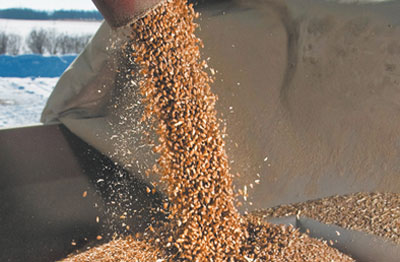
Rivals line up to replace Russia grain to Egypt
London, September 26, 2012
France and other leading global wheat exporters, normally undercut by cheap Russian supplies, are poised to snag new business from top importer Egypt, with Russia's drought-depleted export surplus seen drying up within weeks.
Russian agriculture ministry officials have repeatedly pledged no export restrictions, in spite of crippling hot and dry conditions slicing yields by more than a quarter, but much of the amount available for sale has been exhausted.
Traders said Egypt's state wheat buyer, the General Authority for Supply Commodities (GASC), will see few or no offers for Russian wheat in its tender issued on Tuesday for December shipment.
"Egypt is bound to turn to France as the first alternative to the Black Sea but it will buy as much as possible from Russia, Ukraine, Romania and others while they are still available," said a German trader.
Depressed freight rates are expected to aid the US, Canada, Argentina and Australia to become competitive in coming months too, with the cost of shipping significantly reduced.
The worst US drought in more than half a century and fears of export restrictions from Russia sent wheat prices soaring in June and July, but after an initial surge of purchases early in the 2012/13 marketing year, demand has slowed and prices have eased.
But wheat prices remain around 25 per cent higher than pre-rally levels and traders say the market is awash with offers from a range of origins.
"Latvian, Polish, Danish and German milling wheat are available in good volume," said a European trader. "The whole Baltic has milling wheat, the Balkans has milling wheat, Russia and Ukraine have milling wheat."
Polish and German wheat is included in Egypt's state wheat buyer's tender terms but Danish and Latvian wheat are not.
Earlier this month, Egypt's GASC said it had purchased around seven months of supplies from local and international sources.
During the 2011/12 fiscal year, GASC's purchases were dominated by Black Sea origin wheat, this is consistent with its purchases thus far in 2012/13.
"GASC have bought 1.3 million tonnes of eastern European wheat out of the 1.7 million tonnes they've purchased so far in this campaign," said James Dunsterville, analyst at Geneva-based Agrinews consultancy.
"They can mix this high quality wheat with the 3.7 million tonnes of local wheat they purchased."
Russia barred grain exports for almost a year in August 2010 after a severe drought which led to a wheat crop of just 41.5 million tonnes.
This year the International Grains Council's (IGC) Russian wheat crop forecast is even lower at around 41 million tonnes following another widespread drought.
"It looks as though most people are frightened to sell more Russian wheat. The logistics are getting pretty tight," said Dunsterville.
The Baltic Exchange's main sea freight index, which tracks rates to ship dry commodities and is a bellwether of market sentiment, fell to its lowest level since February earlier this month.
"The Russians have a smaller crop and smaller export availability so the market will have to go to more diverse sources and freight rates are historically low which makes sourcing from those alternative places better," said a European trader.
Whether Russia imposes export restrictions, or there's a de facto ban on shipments as a result of traders being reluctant to offer Russian wheat, it's clear Russia will soon reach the IGC's projected wheat export volume of 8.5 million tonnes for 2012/13.
"There will be an export stop for sure, they have exported far too much, 9 million tonnes is already on their books," said a European trader.
Russia's Deputy Prime Minister Arkady Dvorkovich, responsible for the agriculture sector, has repeatedly ruled out the possibility of export restrictions, estimating Russia's 2012/13 grain exportable surplus at 10-12 million tonnes.
This is around half of Russia's 2011/12 wheat exports, when it was the world's third-largest exporter, but traders said it could regain its position in future if the next crop sees better growing conditions.
For now, GASC is likely to turn to French, Ukrainian, Polish, Romanian and German wheat in the coming tenders, followed by the U.S., Canada, Argentina and Australia in the new year, dealers said.
"In later stages we could see some other EU countries such as Germany and Poland making some sales but I think the French will take the lion's share," said the German trader.
There is also the possibility that GASC could consider adding origins to its existing list to expand its options, traders said.
However, the process for adding origins to the tender terms and conditions can take time as it includes GASC sending a delegation to the country in question to study the wheat quality.-<!--Reuters-->







